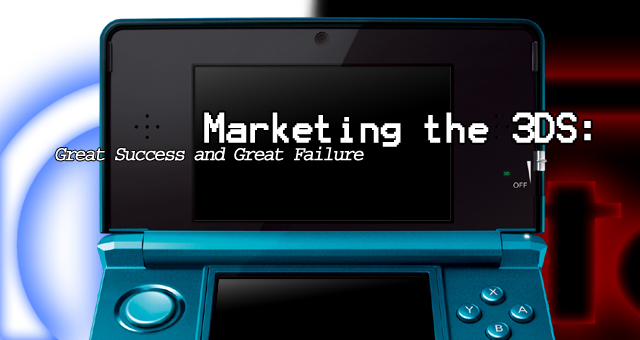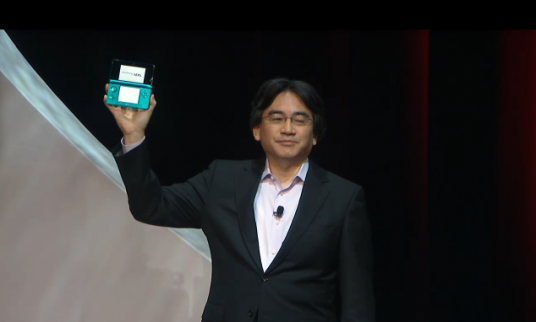Marketing the 3DS: Great Success and Great Failure
Posted on May 15 2011 by Nathanial Rumphol-Janc

The Nintendo 3DS is a very interesting case study for those interested in marketing. Nintendo were presented with a great challenge to successfully promote their newest handheld console as it led up to release. The biggest hurdle of all was that, as the slogan ran, “To believe it, you just have to see it.” How do you market something that consumers can’t appreciate until they’ve already purchased it and experienced it? Taking a closer look at the advertising campaigns for the 3DS, we soon see that while Nintendo overcome these obstacles to have a successful pre-release run, the 3DS’s marketing strategies upon release begun to fail.
The Success
To claim to have produced a portable console that can manage glasses-free 3D, while having no proof to back it up, would have been fatal. That’s why right from the initial announcement at E3 2010, Nintendo had 3DS consoles available for people to truly experience what they were talking about. Nintendo took their biggest problem in the marketing campaign, “To believe it, you just have to see it”, and turned it into the slogan. Now when all of the journalists from online, magazines, the news and wherever else wrote about the 3DS they had experience at E3, they almost all took the slogan and told their readers that they must try it for themselves.
It gave everyone somewhat of a sense of missing out, and it burned within them to give it a try as soon as they could. Some vowed to purchase the console as soon as it came out, or to pre-order it. Then there was a period where we didn’t really hear much about the 3DS, until some public trial events earlier this year. Once again it was about seeing it yourself, to believe it. The trial events were a large success. People were enthralled by the 3D. The media kept praising it and saying you have to try it. Others of us told our friends and family similar things.
The “see it to believe it” problem had become the very driver of the campaign. Unlike things like motion controls or HD that people could tell you about, 3D needed to be experienced. Nintendo knew that, and built a successful campaign around that. Whether intentionally or not on Nintendo’s behalf, the timing of this 3D gaming revolution was perfect, given all of the recent community hype over the film Avatar. With Avatar friends told friends that they have to experience it in 3D. It worked the same for the 3DS, but it had an even bigger pull, because it wasn’t just 3D in the cinemas; it was finally in your own hands.
Another issue faced by Nintendo was if the market just viewed the 3DS as the next incarnation in the DS family, just with an added 3D gimmick. What they needed the world to realize was that this was the next step in portable consoles. Despite DS being in the name 3DS, this was moving beyond a new member to the family like the DSi, or the XL, or even the Lite. This console had so many more new features, such as StreetPass. In fact, 3D was a later edition to the table in this console’s development.
Now, Nintendo did make the 3D gimmick the focus of their advertising campaign, but to have done that alone would have been a mistake. Through media outlets and television advertising, they quickly spread the word of all of the 3DS’s other features. This was a necessity, both to make the console not appear shallow, and to appeal to the people that plainly can’t see 3D. In their commercials Nintendo once again stuck to the “see it to believe it” slogan, basing their ads around personal testimonies and anecdotes. Not only that, but only being able to display 2D images via television allowed Nintendo to show off the stunning 2D graphics, when 3D is turned off. Nintendo was cautious too, giving their seven years of age plus recommendation all throughout the campaign, to avoid health related controversies.
The 3DS appealed to so many people. They just had to try it. Upon release it shattered sales records, and garnered praise in reviews. In the UK it was Nintendo’s most successful hardware launch ever. In the US first day sales were more than any other past Nintendo handheld console. Japan and Australia, amongst other locations, suffered from pre-order sell-outs in some retailers, and first day sell-outs at others. Those who got a 3DS console, showed their friends. People were amazed and stunned. The campaign was successful.

The Failure
Unfortunately, we can’t end this story at the end of the successful launch campaign. As of April 25th, the 3DS had sold 3.61 million units. A good figure no doubt, but Nintendo was expecting 4 million. Something didn’t quite go off as expected, what was it? The same question can be answered by why so many people who are massive Nintendo fans don’t have a 3DS. Some of our staff members don’t even yet, and plenty of our viewers haven’t brought one either. No, the reason isn’t simply that’s its too expensive, the reason is that it isn’t worth the money yet. It’s not worth the money yet simply because of software.
The gimmick itself is now over. You had to see it to believe it. People have seen it and they’ve believed it. They’ve showed it to their friends and family. Their friends and family have seen it, and there’s no need for them to purchase it. People have tried it, but are wondering “what now?” Yes, the console does come with some fun little games like Face Raiders and Augmented Reality, but they’re all about showing off the gimmick. Just like the Mii games are about showing off StreetPass. If we all had endless time for gaming, then maybe we’d be in love with the pre-installed software. The reality is that we don’t, so we’re only going to spend time gaming if there’s software that’s worth it. Nintendo knows that. This is the exact reason that my 3DS sits lonely on the shelf, hardly used.
No doubt the console has potential for software, but Nintendo released this portable solely using the 3D gimmick and future hopes for what games will come to drive it. It is not until things like Ocarina of Time 3D, Kid Icarus, Paper Mario 3D, Mario Kart and Super Mario 3D that this console is really worth it. Nintendo knows and regularly says that a true gaming experience is about the perfect marriage of the hardware and software, yet with the 3DS they’ve relied entirely upon hardware. In most instances, the launch titles like Nintendogs + Cats and Pilotwings Resort did nothing but serve the gimmick, similarly to other third-party launch titles. They were impulse buys so players could experience the 3D. I almost caved into this, but the money wasn’t worth it. Ocarina of Time 3D will be the first 3D journey for most of us. It will also be the reason that many of us finally go out and buy this console.
Reggie said that Nintendo can’t please everybody at launch, which is a true sentiment, however in this case Nintendo have pleased very few at launch. Really, they’ve only pleased the gimmick hunters. Had Ocarina of Time 3D or Mario Kart been a launch title, then I likely wouldn’t be writing this article. Street Fighter IV 3D was the one really strong launch title that provided solid game play and showed off the console’s features, but it wasn’t for everyone. It feels like Nintendo rushed. They wanted to get this console out of the way before E3 2011, and before more announcements like the Wii’s successor came along. In reality I think they should have kept it to after E3, to when there was the software. Japan got Professor Layton and the Mask of Miracle at launch, but elsewhere got nothing comparable.
No doubt it was a successful lead up, but the lack of software to support the system has made all of Nintendo’s efforts fall down. They’ll be hoping that the upcoming stream of software is enough to get the gimmick hunters to take their 3DS off the shelves. Sure Nintendo may have got the sales, but how many consumers are still using the console regularly? How many will go out and buy more software? It is not until some of these upcoming 3DS titles hit that we will truly know whether we can call the 3DS a commercial success or commercial failure.



